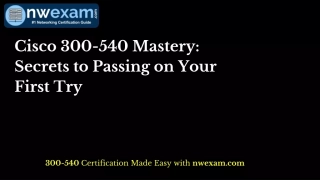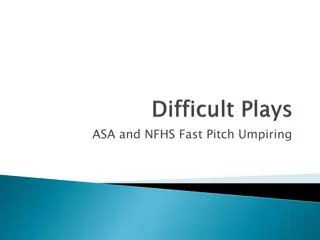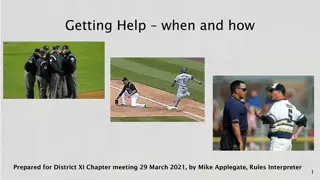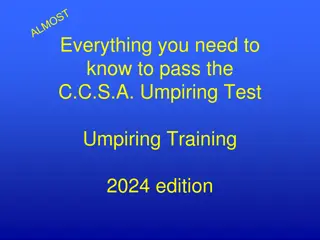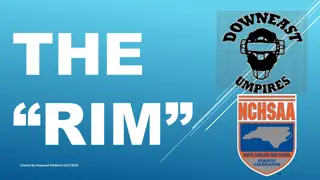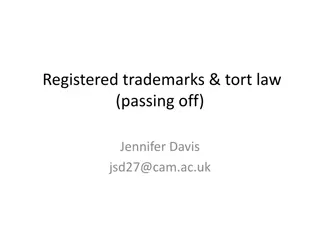Comprehensive Guide to Passing the C.C.S.A. Umpiring Test 2019 Edition
Prepare for the C.C.S.A. Umpiring Test with this comprehensive guide covering topics such as umpiring positioning, game timing, player ages, equipment, and more. Study aids include the Softball Canada Rule book and casebook. Be ready for the 70-question multiple-choice test with tips on what to bring and what to expect during the umpiring evaluation.
Download Presentation

Please find below an Image/Link to download the presentation.
The content on the website is provided AS IS for your information and personal use only. It may not be sold, licensed, or shared on other websites without obtaining consent from the author. Download presentation by click this link. If you encounter any issues during the download, it is possible that the publisher has removed the file from their server.
E N D
Presentation Transcript
Everything you need to know to pass the C.C.S.A. Umpiring Test Umpiring Training 2019 edition
Umpiring Test 70 questions Multiple choice Bring pencils, erasers and a clipboard Closed book. No aids You will need your CCSA ID for check-in, and to bubble in for ump test. 2
Study Aids Softball Canada Rule book CCSA Rules Softball Canada Casebook This presentation 3
Outline Timing of Game Umpiring Positioning Obstruction/Interference Mercy Rule Fair or Foul Hit by Batted Ball Ages of Players Pitching Infield Fly Players & Lineups Batting Intentionally Dropped Ball Uniforms Pop Fly behind Home Alternating Batters Equipment Injuries Batter s Box Ground Rules Batting Out of Order Evaluations Jewelry Overrunning Post Game Diamond & Lines Leadoffs Gestures & Calls Home Run Fence Awarded Bases 4
Start of Game Timing Players Uniform Equipment 5
Timing of Game 15 minute Grace Period Players must be present for Devotions AND Opening Prayer Finish game 15 min prior to start of next game, i.e. game should last 1 hr 30 min After 3 to 4 innings speed up the game Limit time for warm-ups of pitchers & fielders 6
Timing of Game Complete game = 8 innings 7 if home team winning If game shortened (ie weather, not enough time), 5 completed innings considered complete 4 if home team winning 7
Mercy Rule 5-run Mercy Rule Enforced every inning EXCEPT in the last inning of the game, and in extra innings. GAME mercy rule Once the game is official After 5 innings, or 4.5 if home team is leading If difference of 14 or more runs Losing team has the OPTION to end game 8
Ages of Players A player s CCSA age is determined as of December 31st of the current year. Junior division Age 14 to 18 inclusive Allow two 19 year olds on team as leaders (1 male, 1 female) 9
Ages of Players They must obtain a Letter of Approval from their supervising pastor acknowledging that they are to be mentors to future leaders. They will assume a role of either Assistant Governor, Assistant Coach, or Assistant Umpire. 10
Players & Lineups Each team needs 9 players to start the game, at least 3 of which are females No more than 3 males can bat consecutively Defensive team can have 9 or 10 fielders 9 fielders - 1 rover, at least 3 females 10 fielders - 2 rovers, at least 4 females Rovers: M or F Position anywhere in the outfield 11
Full Uniforms A full uniform shall consist of: Team name Legible number (different whole number for each player, 1 or 2 digit) Church name (or acronym) CCSA patch in a visible location Glued or sewn on Sleeves, part of jersey or shirt worn underneath 1 run per improper uniform is deducted BEFORE start of game 12
Full Equipment 3 Bases (safety base for 1st) 2-4 Spikes per Base (6-8 total) 2 Pylons Brand new Game Ball (supplied by C.C.S.A.) 13
Full Equipment Failure of home team to supply proper full equipment: loss of home team status deducted one bonus equipment point If visiting team is able to supply the full equipment set: awarded one bonus equipment point Note offense on scoresheets Original home team still leads devotions If neither team can supply equipment: game results in forfeit by original home team 14
Full Equipment Failure of home team to supply a new game ball: loss of home team status deducted one bonus equipment point Use best available ball as replacement Note offense on scoresheets 15
Bats Legal, unless on ASA NON-Approved list Legal and only: Legal only: Illegal 16
Helmets For Juniors: Mandatory for all batters, base runners, and on deck batters Pitchers must have an helmet with face cage Rule also applies to Senior players under the age of 18 on date of game 17
Helmets Junior teams unable to provide helmets: Opposing team can share helmets = 1 bonus equipment point If opposing team chooses not to share = Forfeit If a Senior player with no helmet is ineligible to play and this results in less than the minimum number of players, then the offending team forfeits. 18
Ground Rules Define Lines Foul & Dead Ball Territories Jewelry, Swearing Thrown Bat Bunting / Chopped Balls Pop Ups behind Home Plate Batter s Box Overrunning Leadoffs 19
Diamond and Lines 150 Line Infield Line Foul line 60 Player s Line Dead ball Territory 2 m Pitcher s Line 40 20 Commitment Line Safe Line 20 Back fence
Name the LINES G A F B C A Infield Line B Player s Line C Pitcher s Line D Commitment Line E Safe Line F Foul Line G 150 line D E 21
Identify the distances v i ii iii i 60 ii 2m iii 40 ii 20 v 150 iv 22
Shade in the orange part of the safety base on the diamond above. Draw in Home Plate on the diamond above. 23
Draw the straps of 2nd base and 3rd base on the diamond above. The straps for 1st base are already drawn in for you. How many spikes do you need to nail down all three bases? 24
Jewelry 1st infraction: Not an ejection Subsequent infractions: Ejection Offence: If batter/runner is wearing jewelry, first penalty is an out. Defence: If defensive player is found to be wearing jewelry, obstruction will be called and the current batter and runners will be awarded 1 base. The defensive player will be required to remove the jewelry at that time. 25
Safety Base 1st base Fielders always touch white Runners must touch orange on any potential plays at 1st Runners may touch any part of 1st when ball is hit to outfield If fielder touches orange Obstruction If runner touches white during a play at 1st Interference 26
Outfield throws to 1B An outfielder or rover CANNOT throw a ball directly to 1B to get the (BR) Batter Runner out. Umpire shall signal OBSTRUCTION Both teams shall receive a WARNING Subsequent violation = EJECTION When the BR safely reached 1st base, OF or R may throw ball directly to 1B for a tag out. Note: This rule is applied on the THROW from any outfielder or rover to 1B. The fielder at or near 1B need not make a play for the obstruction to occur. 27
150 Line Line (marked by pylons), 150 feet from home plate, arcing from one foul line to another Not straight line from one pylon to another Rovers & outfielders cannot be in front of the 150 line at the start of play May only pass 150 line after pitched ball is hit If violated: Obstruction will be called and a delay dead ball will be signalled. 28
Infield Line This line distinguishes the infield and the outfield. Grass line To throw the ball to the pitcher, OF/R must be standing in the infield (within the infield line) 29
Players Line This line is drawn from 1st base to 3rd base No infielder with the exception of the pitcher and catcher may be in front of this line until the pitched ball is hit. If violated: obstruction will be called and a delay dead ball will be signalled. 30
Commitment Line 20 ft from home plate When a runner crosses this line (1 foot completely over line & touching ground) but does not reach the safe line, he is called out when a defensive player has the ball and is in contact with home plate No tag is necessary Runners who have not crossed the line or runners who crossed the line but must tag up or missed a base, may return to third base 31
Safe Line Drawn from the front corner of the home plate When a runner touches the ground on or beyond the safe line prior to a defensive player legally holding the ball while in contact with home plate, the runner is safe Tagging of runners between commitment and safe lines will be considered an obstruction Runner will be called out for touching home plate or sliding across the safe line Exception: in attempts to avoid a collision 32
Home Run Fence A team may hit one Over-the-Fence HR more than the opposing team. Subsequent Over-the-Fence hits will count as OUTS until the opposing team hits an Over- the-Fence HR. This is what will be referred to as Match + 1 If a ball bounces on the ground and then goes over the fence, it is a ground-rule double 33
Home Run Fence EXCEPTION: Should awarding a home run or a ground rule double result in more than 5 runs scoring in an inning in which the mercy rule is enforced, only 5 runs will be scored and recorded for that inning. The batter and runners are awarded the maximum number of bases such that no more than 5 runs score in the inning. For the purpose of the Match+1 rule, the over the fence hit is still counted as a Home Run. 34
Umpiring Positioning Base Umps Stand where you will see the play Home Umps Do not lean on fence Have a good view of the whole field Do not totally rely on your base umps 35
Recommended Umpiring positions Don t stand on foul line or in foul territory when making calls at 1st base For plays at 2nd base For plays at 3rd base For plays at 1st base Home ump - When all plays are occurring in the outfield Home ump - When runners coming to score (line up with safe line) Home ump For left- handed batters Home ump For right- handed batters 36
Fair or Foul? Fair Settles or is touched on fair ground between home & 1st base or between home & 3rd base Bounds past 1st or 3rd base on or over fair ground Touches 1st, 2nd or 3rd base While on or over fair ground touches the person or clothing of an umpire or player First falls on fair ground beyond 1st or 3rd base While over fair territory passed out of the playing field beyond the outfield fence Hits a foul line pole on the fly 37
Fair or Foul? Foul Settles on foul ground between home & 1st base or between home & 3rd base Bounds past 1st or 3rd base on or over foul ground While on or over foul ground touches the person or clothing of an umpire, player or any object foreign to the natural ground 38
Bat hits ball a second time Bat in the hands of batter when ball comes in contact with ball a second time: If batter is in batter s box Foul Ball. If an entire foot of batter is completely outside batter s box & touching ground OUT. Bat is out of batter s hands (dropped): Deliberately hits ball in fair territory DEAD BALL, Batter is out. Ball hits bat on ground, batter NOT OUT. Bat in fair territory: FAIR/FOUL depending on where ball is touched or where it settles Bat in foul territory: FOUL 39
Fair or Foul? FAIR 5. A runner is standing on third, one leg on the base and the other in foul territory. Ground ball hits the leg that is on the base. 40
Fair or Foul? FAIR 7. The ball rolls directly along the foul line, touches a corner of the base and then rolls foul, never passing the base. 41
Pitching Number of pitches 3 per batter Pitcher must keep one foot behind pitcher s line Pitcher must be within 1 m of middle of diamond (imaginary line between home and 2nd) Batter called out if batted ball hits pitcher before fielders have a chance to play it A ball may be returned to the pitcher once the play is over, by a player in the INFIELD. 42
Batting Thrown bats Automatic out, dead ball Next thrown bat = out + ejection Bunt = Contact between bat & ball which does not involve a full swing Chopped balls = Ball hit with a full downward swing (Motion of bat determines if the ball is chopped; not motion of ball) Bunt or Chopped ball = OUT + dead ball 43
Pop Fly Behind Home A batted ball in foul territory behind the batter will be considered an out if it is legally caught, no matter the height it reaches. 44
Batters Box Batter s feet must remain within the batter s box at the time of a swing (with contact with ball) If batter steps on or in front of home plate when his/her swing makes contact with the pitched ball, he/she will immediately be called out. Play is dead, all runners return to last base touched before the hit. 45
Batting Out of Order When a team bats out of order, the play may be appealed, even after the batter has completed the at-bat, as long as it is BEFORE the next pitch. Batting Order 3rd inning M1 M1 batted M2 M3 bats after M1, skipping M2 M3 F1 46
Batting Out of Order M1 batted Batting Order M1 M2 M3 F1 M3 bats after M1, skipping M2 Before improper batter (M3) completes at bat Proper batter (M2) take place in batter s box M2 assumes pitch count After improper batter (M3) completes at bat, but before next pitch After first pitch to next batter, F1 When is appeal made? Proper batter (M2) out Runners advanced due to actions of improper batter nullified Next batter is batter who follows the proper batter (M2) called out = M3 All runs scored and bases run are legal. Next batter is the one who follows improper batter = F1 M2 skipped, not out Calling 47
Overrunning Any batter-runner can overrun 1st base Any player overrunning 2nd or 3rd base will be liable to be put out 48
Leadoffs Runners may not leave their bases until a pitched ball is hit Runners caught leading off are immediately called out Play is dead Ball is re-pitched 49
Awarded Bases Bases awarded when: Thrown ball goes out of play A glove is thrown at the ball A defensive player goes out of play with the ball One base is awarded When fielder UNINTENTIONALLY enters dead ball area with ball in possession (note time of infraction) 50








